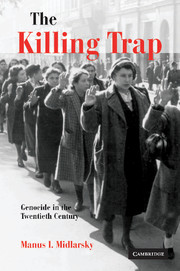Book contents
2 - Case selection
Published online by Cambridge University Press: 22 September 2009
Summary
As stated in the introduction, genocide is understood to be the state-sponsored systematic mass murder of innocent and helpless men, women, and children denoted by a particular ethnoreligious identity, with the purpose of eradicating that group from a given territory. Vulnerability of the targeted group and a real or purported connection with threats to state security (e.g., ethnic kin in an enemy state) are necessary conditions for the genocide to occur.
Two elements are critical in defining genocide. First is the matter of state policy. Was it the policy of the perpetrating state to commit mass murder with exterminatory intent? If so, then the number of people murdered would be vastly greater than if such a policy were absent. Second, were non-combatants of a particular ethnoreligious identity subject to the mass murder? If large numbers of men were killed on the battlefields of Flanders or elsewhere during World War I, it is a substantially different matter than if they, as civilians, were killed along with their families in the Nazi gas chambers of World War II. In the former instance, they are typically (but not always) men fighting on behalf of their country. In the latter, they are victims of an exterminatory state policy. Thus, the two elements critical for selecting cases for analysis are the existence of a state policy demanding the systematic mass murder of an ethnoreligious group and the implementation of that policy.
- Type
- Chapter
- Information
- The Killing TrapGenocide in the Twentieth Century, pp. 22 - 40Publisher: Cambridge University PressPrint publication year: 2005



